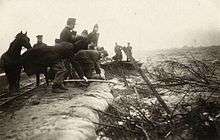Flood of 1916
The flood of 1916 or Zuiderzeevloed of 1916 is a flood that took place in the night between 13 and 14 January 1916 in the Netherlands along the dikes of the Zuiderzee caused by a tempest.

Course
The flood coincided with a high water inflow of rivers causing many ruptures at dozens of places along the coastline, and damaging the structure of many dikes. Some wooden houses on the island of Marken completely tumbled over. In the province Noord-Holland 19 people were killed and, at sea, several ships were wrecked causing another 32 casualties. Queen Wilhelmina visited the areas that were hit.

Train
This disaster, in combination with the famine caused by the First World War, led to a law called Zuiderzeewet. The reinforcement of the dikes, undertaken after the disaster, was finished in 1926. In 1932, the Zuiderzee was 'tamed' by constructing a 32-kilometre long dike or, better said, a barrage called the Afsluitdijk. For the fishermen, this also led to the end of their fishing activities.
Foreign help
Based on the correspondence in the Hague between the ambassador of Turkey to the government of the Netherlands, the Turks donated a sum of FL 2387.90 (equivalent of about €20,000 now) to the Netherlands in aid for the victims of the flood.[1]
References
- Redactie. "Turkse hulp aan Nederlanders tijdens watersnoodramp 1916 - DutchTurks". DutchTurks (in Dutch). Retrieved 2016-03-02.